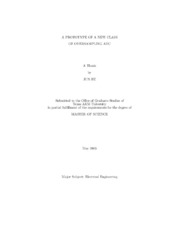| dc.description.abstract | Analog-to-digital (A/D) and digital-to-analog (D/A) converters are important
blocks in signal processing system because they provide the link between the analog
world and digital systems. Compared with Nyquist-rate data converters, oversampling
data converters are more desirable for modern submicron technologies with low
voltage supplies. Today, all existing oversampling modulators in popular use are derived
from sigma-delta modulation. Stability is the most significant problem in the
sigma-delta modulator, because the ultimate accuracy is limited by stability. As the
aggressiveness of the design increases, the margin of stability diminishes rapidly.
This thesis presents the design and experimental results of the first prototype
circuit implementation of the novel oversampling modulation scheme proposed by
Dr. Takis Zourntos. This new class of oversampling modulators are theoretically
stable. With less stability limitation, the new class of modulators can potentially
achieve higher signal-to-noise ratio (SNR) or less power by designing the modulator
more aggressively. This thesis describes the methods and procedures of how the new
oversampling modulation theory is implemented into a circuit. Some novel circuit
architectures are proposed in this modulator, such as a filter which can provide status
outputs for the controller and realize arbitrary zeros and poles, comparators with
synchronization latches to eliminate the effect of metastability, and a digital-to-analog converter (DAC) with current calibration circuits for high linearity.
A third-order continuous-time oversampling modulator employing 4-bit quantization
is implemented in a 0.35-µm double-poly complementary metal oxide semiconductor
(CMOS) technology, with a chip area of 2150 × 2150 µm2. Simulation results
show it achieves 83.7-dB peak SQNR, 90-dB dynamic range over a 500kHz input
signal bandwidth, and 60 mW power consumption. | en |


